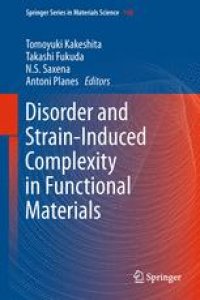
Ebook: Disorder and Strain-Induced Complexity in Functional Materials
- Tags: Structural Materials, Magnetism Magnetic Materials, Ceramics Glass Composites Natural Methods, Nanoscale Science and Technology, Applied and Technical Physics
- Series: Springer Series in Materials Science 148
- Year: 2012
- Publisher: Springer-Verlag Berlin Heidelberg
- Edition: 1
- Language: English
- pdf
This book brings together an emerging consensus on our understanding of the complex functional materials including ferroics, perovskites, multiferroics, CMR and high-temperature superconductors. The common theme is the existence of many competing ground states and frustration as a collusion of spin, charge, orbital and lattice degrees of freedom in the presence of disorder and (both dipolar and elastic) long-range forces. An important consequence of the complex unit cell and the competing interactions is that the emergent materials properties are very sensitive to external fields thus rendering these materials with highly desirable, technologically important applications enabled by cross-response.
This book brings together an emerging consensus on our understanding of the complex functional materials including ferroics, perovskites, multiferroics, CMR and high-temperature superconductors. The common theme is the existence of many competing ground states and frustration as a collusion of spin, charge, orbital and lattice degrees of freedom in the presence of disorder and (both dipolar and elastic) long-range forces. An important consequence of the complex unit cell and the competing interactions is that the emergent materials properties are very sensitive to external fields thus rendering these materials with highly desirable, technologically important applications enabled by cross-response.
This book brings together an emerging consensus on our understanding of the complex functional materials including ferroics, perovskites, multiferroics, CMR and high-temperature superconductors. The common theme is the existence of many competing ground states and frustration as a collusion of spin, charge, orbital and lattice degrees of freedom in the presence of disorder and (both dipolar and elastic) long-range forces. An important consequence of the complex unit cell and the competing interactions is that the emergent materials properties are very sensitive to external fields thus rendering these materials with highly desirable, technologically important applications enabled by cross-response.
Content:
Front Matter....Pages i-xv
Domain Boundary Engineering in Ferroic and Multiferroic Materials: A Simple Introduction....Pages 1-18
Phase Diagrams of Conventional and Inverse Functional Magnetic Heusler Alloys: New Theoretical and Experimental Investigations....Pages 19-47
Ni–Mn–X Heusler Materials....Pages 49-65
Magnetic Interactions Governing the Inverse Magnetocaloric Effect in Martensitic Ni–Mn-Based Shape-memory Alloys....Pages 67-77
Magnetic Field-Induced Strain in Ferromagnetic Shape Memory Alloys Fe-31.2Pd, Fe3Pt, and Ni2MnGa....Pages 79-94
Soft Electronic Matter: Inhomogeneneous Phases in Strongly Correlated Condensed Matter....Pages 95-112
Defects in Ferroelectrics....Pages 113-134
High-Resolution Visualization Techniques: Structural Aspects....Pages 135-149
High-Resolution Visualizing Techniques: Magnetic Aspects....Pages 151-176
Understanding Glassy Phenomena in Materials....Pages 177-199
Strain Glass and Strain Glass Transition....Pages 201-225
Precursor Nanoscale Textures in Ferroelastic Martensites....Pages 227-247
Metastability, Hysteresis, Avalanches, and Acoustic Emission: Martensitic Transitions in Functional Materials....Pages 249-272
Entropy–Driven Conformations Controlling DNA Functions....Pages 273-292
Conclusion and Outlook....Pages 293-301
Back Matter....Pages 303-308
This book brings together an emerging consensus on our understanding of the complex functional materials including ferroics, perovskites, multiferroics, CMR and high-temperature superconductors. The common theme is the existence of many competing ground states and frustration as a collusion of spin, charge, orbital and lattice degrees of freedom in the presence of disorder and (both dipolar and elastic) long-range forces. An important consequence of the complex unit cell and the competing interactions is that the emergent materials properties are very sensitive to external fields thus rendering these materials with highly desirable, technologically important applications enabled by cross-response.
Content:
Front Matter....Pages i-xv
Domain Boundary Engineering in Ferroic and Multiferroic Materials: A Simple Introduction....Pages 1-18
Phase Diagrams of Conventional and Inverse Functional Magnetic Heusler Alloys: New Theoretical and Experimental Investigations....Pages 19-47
Ni–Mn–X Heusler Materials....Pages 49-65
Magnetic Interactions Governing the Inverse Magnetocaloric Effect in Martensitic Ni–Mn-Based Shape-memory Alloys....Pages 67-77
Magnetic Field-Induced Strain in Ferromagnetic Shape Memory Alloys Fe-31.2Pd, Fe3Pt, and Ni2MnGa....Pages 79-94
Soft Electronic Matter: Inhomogeneneous Phases in Strongly Correlated Condensed Matter....Pages 95-112
Defects in Ferroelectrics....Pages 113-134
High-Resolution Visualization Techniques: Structural Aspects....Pages 135-149
High-Resolution Visualizing Techniques: Magnetic Aspects....Pages 151-176
Understanding Glassy Phenomena in Materials....Pages 177-199
Strain Glass and Strain Glass Transition....Pages 201-225
Precursor Nanoscale Textures in Ferroelastic Martensites....Pages 227-247
Metastability, Hysteresis, Avalanches, and Acoustic Emission: Martensitic Transitions in Functional Materials....Pages 249-272
Entropy–Driven Conformations Controlling DNA Functions....Pages 273-292
Conclusion and Outlook....Pages 293-301
Back Matter....Pages 303-308
....
Download the book Disorder and Strain-Induced Complexity in Functional Materials for free or read online
Continue reading on any device:

Last viewed books
Related books
{related-news}
Comments (0)